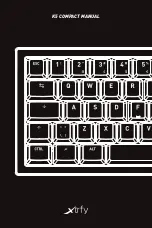
System Exclusive Protocol
K2661 System Exclusive Implementation
7-3
The bit-stream format can be thought of as taking the binary bits of the K2661 data and, starting
from the left, slicing off groups of 7 bits. Note that the trailing bits are set to zero.
After the
data
fi
eld, there is another
fi
eld,
xsum
. This is a checksum
fi
eld that is calculated as the
least signi
fi
cant 7-bits of the sum of all of the MIDI bytes that make up the
data
fi
eld.
Messages
This section de
fi
nes the K2661 System Exclusive message formats. Each message has a message
type, which goes in the
msg-type
fi
eld (see
Common Format
on page 7-1), followed by the
fi
eld
de
fi
nitions of the message.
DUMP = 00h
type(2) idno(2) offs(3) size(3) form(1)
Requests the K2661 to send a data dump of an object or portion thereof.
type
and
idno
identify
the object.
offs
is the offset from the beginning of the object’s data;
size
describes how many
bytes should be dumped starting from the offset.
form
indicates how the binary data are to
transmitted (0=nibblized, 1=bit stream). The response is a LOAD message:
LOAD = 01h
type(2) idno(2) offs(3) size(3) form(1) data(n) xsum(1)
This writes data into the speci
fi
ed object, which must exist. Both load and dump operate on the
object data only. The response to a load message will be the following:
DACK = 02h
type(2) idno(2) offs(3) size(3)
Load accepted, or
DNAK = 03h
type(2) idno(2) offs(3) size(3) code(1)
Load not accepted. The
code
fi
eld indicates the cause of the failure, as follows:
To request information about an object, use:
DIR = 04h
type(2) idno(2)
The
type
and
idno
identify the object. The response is an INFO message:
INFO = 05h
type(2) idno(2) size(3) ramf(1) name(n)
This is the response to DIR, NEW, or DEL. If object is not found,
size
will be zero and
name
will
be null.
ramf
is 1 if the object is in RAM.
Code
Meaning
1
Object is currently being edited
2
Incorrect checksum
3
ID out of range (invalid)
4
Object not found (no object with that ID exists)
5
RAM is full
Summary of Contents for K2661
Page 18: ...2 4 LFOs LFO Shapes...
Page 34: ...3 16 DSP Algorithms...
Page 54: ...5 4 MIDI Note Numbers Note Numbers for Percussion Keymaps...
Page 72: ...7 10 System Exclusive Protocol K2661 System Exclusive Implementation...
Page 82: ...9 4 Upgrading Sample Memory Choosing and Installing a SIMM for K2661 Sample Memory...
Page 334: ...10 252 KDFX Reference KDFX Algorithm Specifications...
Page 340: ...11 6 Glossary...
Page 382: ...12 42 Triple Modular Processing Alphanumeric Buttonpad Entries for DSP Functions...
Page 392: ...B 6 SysEx Control of KDFX MSB and LSB...
Page 442: ...D 20 Contemporary ROM Block Objects Controller Assignments Contemporary ROM Block...
Page 490: ...H 12 General MIDI Standard Mode Controller Assignments...
Page 492: ...I 2 Live Mode Objects Live Mode Programs...
Page 498: ...K2661 Musician s Reference Index...
Page 500: ......
















































